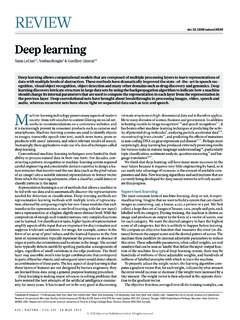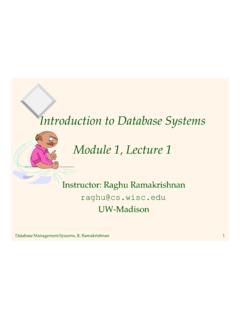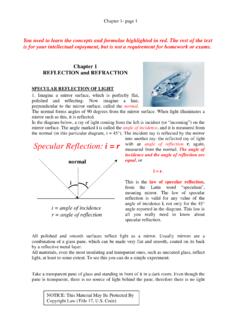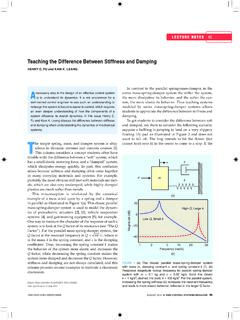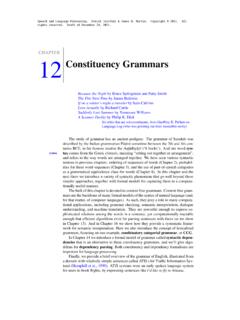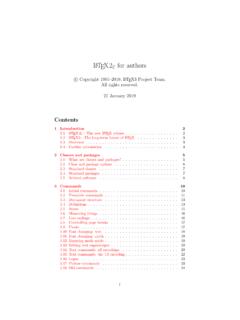Transcription of Distributed Systems
1 48 Distributed SystemsDistributed Systems have changed the face of the world. When your webbrowser connects to a web server somewhere else on the planet, it is par-ticipating in what seems to be a simple form of aclient/serverdistributedsystem. When you contact a modern web service such as Google or Face-book, you are not just interacting with a single machine, however;be-hind the scenes, these complex services are built from a large collection( , thousands) of machines, each of which cooperate to provide the par-ticular service of the site. Thus, it should be clear what makesstudyingdistributed Systems interesting. Indeed, it is worthy of an entire class;here, we just introduce a few of the major number of new challenges arise when building a Distributed major one we focus on isfailure; machines, disks, networks, andsoftware all fail from time to time, as we do not (and likely, willnever)know how to build perfect components and Systems . However, whenwe build a modern web service, we d like it to appear to clients as if itnever fails; how can we accomplish this task?
2 THECRUX:HOWTOBUILDSYSTEMSTHATWORKWHENCOM PONENTSFAILHow can we build a working system out of parts that don t work correctlyall the time? The basic question should remind you of some of the topicswe discussed in RAID storage arrays; however, the problems heretendto be more complex, as are the , while failure is a central challenge in constructing dis-tributed Systems , it also represents an opportunity. Yes, machines fail;but the mere fact that a machine fails does not imply the entire systemmust fail. By collecting together a set of machines, we can builda sys-tem that appears to rarely fail, despite the fact that its components failregularly. This reality is the central beauty and value of Distributed sys-tems, and why they underly virtually every modern web serviceyou use,including Google, Facebook, : COMMUNICATIONISINHERENTLYUNRELIABLEIn virtually all circumstances, it is good to view communicationas afundamentally unreliable activity. Bit corruption, down or non-workinglinks and machines, and lack of buffer space for incoming packets all leadto the same result: packets sometimes do not reach their destination.
3 Tobuild reliable services atop such unreliable networks, we must considertechniques that can cope with packet important issues exist as well. Systemperformanceis often crit-ical; with a network connecting our Distributed system together, systemdesigners must often think carefully about how to accomplish their giventasks, trying to reduce the number of messages sent and further makecommunication as efficient (low latency, high bandwidth) as ,securityis also a necessary consideration. When connectingto a remote site, having some assurance that the remote party is whothey say they are becomes a central problem. Further, ensuringthat thirdparties cannot monitor or alter an on-going communication between twoothers is also a this introduction, we ll cover the most basic aspect that is newina Distributed system:communication. Namely, how should machineswithin a Distributed system communicate with one another? We llstartwith the most basic primitives available, messages, and build a few higher-level primitives on top of them.
4 As we said above, failure will be acentralfocus: how should communication layers handle failures? Communication BasicsThe central tenet of modern networking is that communication is fun-damentally unreliable. Whether in the wide-area Internet,or a local-areahigh-speed network such as Infiniband, packets are regularlylost, cor-rupted, or otherwise do not reach their are a multitude of causes for packet loss or corruption. Some-times, during transmission, some bits get flipped due to electrical or othersimilar problems. Sometimes, an element in the system, such as anet-work link or packet router or even the remote host, are somehow dam-aged or otherwise not working correctly; network cables do accidentallyget severed, at least fundamental however is packet loss due to lack of bufferingwithin a network switch, router, or endpoint. Specifically, even if wecould guarantee that all links worked correctly, and that all the compo-nents in the system (switches, routers, end hosts) were up and running asexpected, loss is still possible, for the following reason.
5 Imagine a packetarrives at a router; for the packet to be processed, it must be placed inmemory somewhere within the router. If many such packets arriveatOPERATINGSYSTEMS[ ] client codeint main(int argc, char*argv[]) {int sd = UDP_Open(20000);struct sockaddr_in addrSnd, addrRcv;int rc = UDP_FillSockAddr(&addrSnd, " ", 10000);char message[BUFFER_SIZE];sprintf(message, "hello world");rc = UDP_Write(sd, &addrSnd, message, BUFFER_SIZE);if (rc > 0)int rc = UDP_Read(sd, &addrRcv, message, BUFFER_SIZE);return 0;}// server codeint main(int argc, char*argv[]) {int sd = UDP_Open(10000);assert(sd > -1);while (1) {struct sockaddr_in addr;char message[BUFFER_SIZE];int rc = UDP_Read(sd, &addr, message, BUFFER_SIZE);if (rc > 0) {char reply[BUFFER_SIZE];sprintf(reply, "goodbye world");rc = UDP_Write(sd, &addr, reply, BUFFER_SIZE);}}return 0;}Figure :Example UDP Code ( , )once, it is possible that the memory within the router cannot accommo-date all of the packets. The only choice the router has at that pointistodropone or more of the packets.
6 This same behavior occurs at endhosts as well; when you send a large number of messages to a singlema-chine, the machine s resources can easily become overwhelmed, and thuspacket loss again , packet loss is fundamental in networking. The question thusbecomes: how should we deal with it? Unreliable Communication LayersOne simple way is this: we don t deal with it. Because some appli-cations know how to deal with packet loss, it is sometimes useful toletthem communicate with a basic unreliable messaging layer, anexampleof theend-to-end argumentone often hears about (see theAsideat endof chapter). One excellent example of such an unreliable layeris foundc 2008 19, ARPACI-DUSSEAUTHREEEASYPIECES4 DISTRIBUTEDSYSTEMSint UDP_Open(int port) {int sd;if ((sd = socket(AF_INET, SOCK_DGRAM, 0)) == -1)return -1;struct sockaddr_in myaddr;bzero(&myaddr, sizeof(myaddr)); = AF_INET; = htons(port); = INADDR_ANY;if (bind(sd, (struct sockaddr*) &myaddr,sizeof(myaddr)) == -1) {close(sd);return -1;}return sd;}int UDP_FillSockAddr(struct sockaddr_in*addr,char*hostname, int port) {bzero(addr, sizeof(struct sockaddr_in));addr->sin_family = AF_INET; // host byte orderaddr->sin_port = htons(port); // network byte orderstruct in_addr*in_addr;struct hostent*host_entry;if ((host_entry = gethostbyname(hostname)) == NULL)return -1;in_addr = (struct in_addr*) host_entry->h_addr;addr->sin_addr =*in_addr;return 0;}int UDP_Write(int sd, struct sockaddr_in*addr,char*buffer, int n) {int addr_len = sizeof(struct sockaddr_in).}
7 Return sendto(sd, buffer, n, 0, (struct sockaddr*)addr, addr_len);}int UDP_Read(int sd, struct sockaddr_in*addr,char*buffer, int n) {int len = sizeof(struct sockaddr_in);return recvfrom(sd, buffer, n, 0, (struct sockaddr*)addr, (socklen_t*) }Figure :A Simple UDP Library ( )OPERATINGSYSTEMS[ ] : USECHECKSUMSFORINTEGRITYC hecksums are a commonly-used method to detect corruption quicklyand effectively in modern Systems . A simple checksum is addition: justsum up the bytes of a chunk of data; of course, many other more sophis-ticated checksums have been created, including basic cyclic redundancycodes (CRCs), the Fletcher checksum, and many others [MK09].In networking, checksums are used as follows. Before sending a messagefrom one machine to another, compute a checksum over the bytes of themessage. Then send both the message and the checksum to the desti-nation. At the destination, the receiver computes a checksum over theincoming message as well; if this computed checksum matches the sentchecksum, the receiver can feel some assurance that the data likely didnot get corrupted during can be evaluated along a number of different axes.)
8 Effective-ness is one primary consideration: does a change in the data lead to achange in the checksum? The stronger the checksum, the harderit is forchanges in the data to go unnoticed. Performance is the other importantcriterion: how costly is the checksum to compute? Unfortunately,effec-tiveness and performance are often at odds, meaning that checksums ofhigh quality are often expensive to compute. Life, again, isn theUDP/IPnetworking stack available today on virtually all modernsystems. To use UDP, a process uses thesocketsAPI in order to create acommunication endpoint; processes on other machines (or on the samemachine) send UDPdatagramsto the original process (a datagram is afixed-sized message up to some max size).Figures and show a simple client and server built on topofUDP/IP. The client can send a message to the server, which then respondswith a reply. With this small amount of code, you have all you need tobegin building Distributed Systems !UDP is a great example of an unreliable communication layer.
9 If youuse it, you will encounter situations where packets get lost (dropped) andthus do not reach their destination; the sender is never thus informed ofthe loss. However, that does not mean that UDP does not guard againstany failures at all. For example, UDP includes achecksumto detect someforms of packet , because many applications simply want to send data toadestination and not worry about packet loss, we need more. Specifically,we need reliable communication on top of an unreliable Reliable Communication LayersTo build a reliable communication layer, we need some new mech-anisms and techniques to handle packet loss. Let us consider a simplec 2008 19, ARPACI-DUSSEAUTHREEEASYPIECES6 DISTRIBUTEDSYSTEMSS ender[send message]Receiver[receive message][send ack][receive ack]Figure :Message Plus AcknowledgmentSender[send message; keep copy; set timer] (waiting for ack)..[timer goes off; set timer/retry][receive message][send ack][receive ack; delete copy/timer off]Figure :Message Plus Acknowledgment: Dropped Requestexample in which a client is sending a message to a server over an unreli-able connection.
10 The first question we must answer: how does the senderknow that the receiver has actually received the message?The technique that we will use is known as anacknowledgment, orackfor short. The idea is simple: the sender sends a message to the re-ceiver; the receiver then sends a short message back toacknowledgeitsreceipt. Figure depicts the the sender receives an acknowledgment of the message, it canthen rest assured that the receiver did indeed receive the original mes-sage. However, what should the sender do if it does not receive an ac-knowledgment?To handle this case, we need an additional mechanism, known as atimeout. When the sender sends a message, the sender now sets a timerto go off after some period of time. If, in that time, no acknowledgmenthas been received, the sender concludes that the message has been sender then simply performs aretryof the send, sending the samemessage again with hopes that this time, it will get through. Forthisapproach to work, the sender must keep a copy of the message around,in case it needs to send it again.
